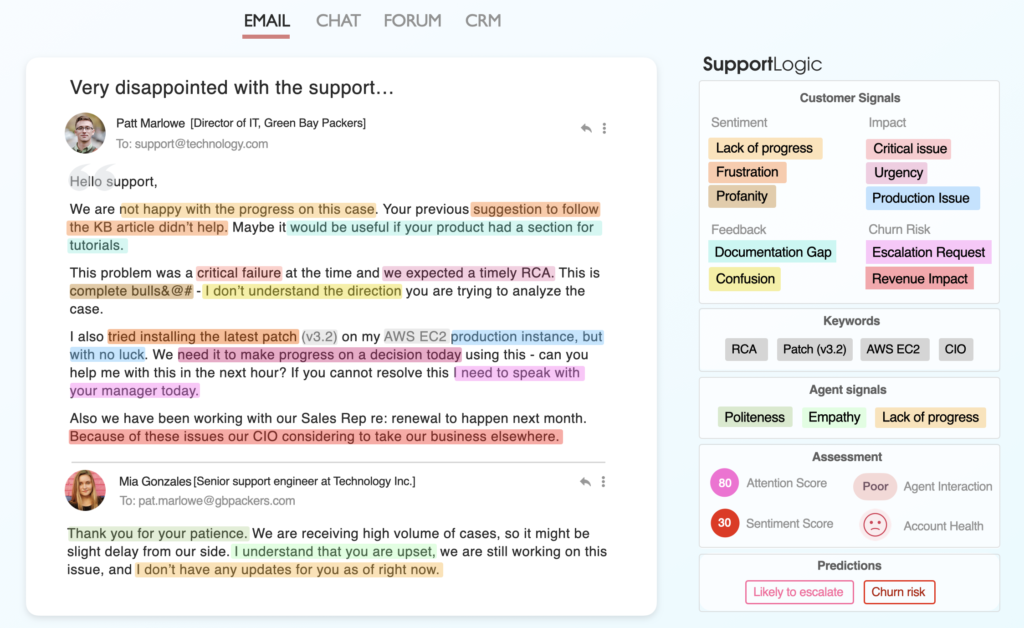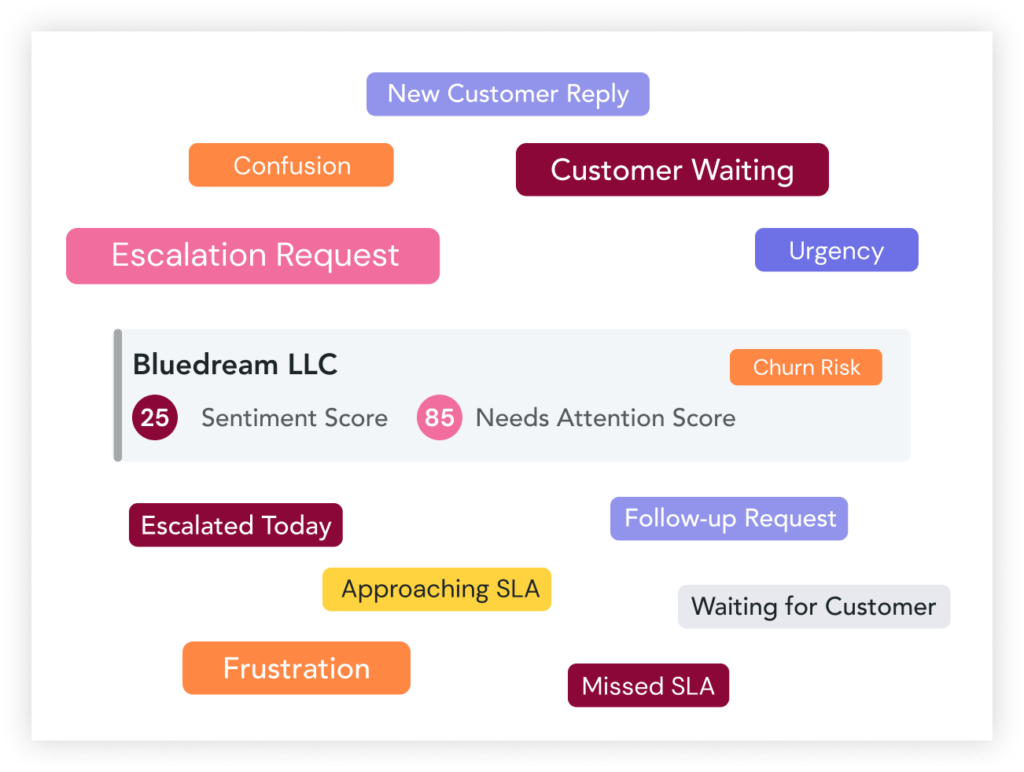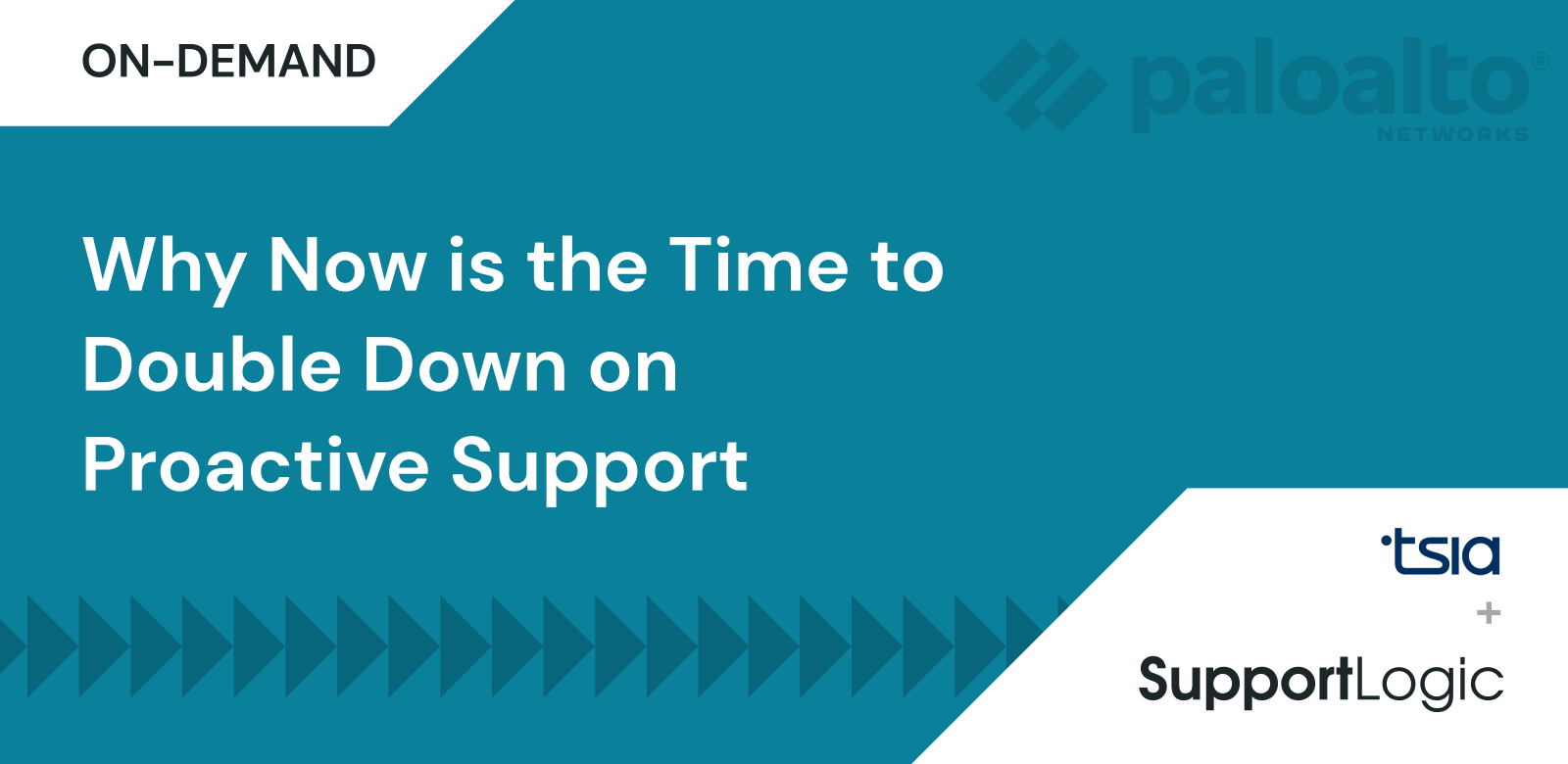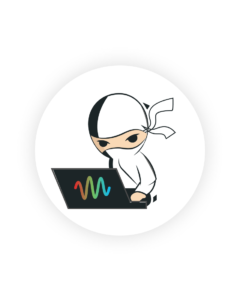
Apr 11, 2022
What is Customer Sentiment Analysis and Ways It Improves the Customer Experience
customer experiencecustomer sentiment analysis
We often discuss the value you can extract from unstructured customer data. But how do you use that data to improve the customer experience (CX) in immediate, tangible ways? The answer lies in customer sentiment analysis.
Customer sentiment analytics is a trending topic in the CX space, and for good reason. “Sentiment analysis,” Bain & Company recently reported, “is a powerful way to keep a pulse on customers and even the broader population to understand changing needs and anxieties, and new moments of truth.”
With over 60% of customers reporting that “they now have higher customer service standards,” there’s no better time to leverage customer sentiment analysis. Learn how to capture valuable, actionable insights that will improve the customer experience and benefit your entire business.
What is customer sentiment analysis?
Customer sentiment analysis refers to the automated process of discovering and measuring how customers feel about your product, brand, or service.
If you’re running a modern support team, you probably have a good amount of customer data on your hands. Your reps are connecting with customers frequently across many touchpoints—from chat and video calls to emails—leaving the voice of the customer sitting in the discussion or transcripts, full of valuable information about your audience’s preferences. Customer sentiment analysis helps companies unlock this information, providing deep insights into the minds of their customers.
“What gets measured gets managed and service is more important than ever,” explains Charles Monnett, director of data engineering at SupportLogic. “Customers are really informed, they have a lot of options, and it’s very easy to discover new products. You shouldn’t assume that just because you’ve got a customer, you will retain them for life. You have to take advantage of every opportunity to provide them with a good experience.”
There are several types of customer sentiment analysis:
- Fine-grained analysis measures sentiment by determining the polarity score of words in a text, from very positive to very negative.
- Emotion detection identifies and analyzes customers’ emotions and moods within the text. While fine-grained analysis measures whether the customer seems positive or negative, emotion detection labels specific emotions.
- Aspect-based sentiment analysis breaks text into parts—phrases, sentences, and tokens—and measures the accompanying sentiment.
With customer sentiment analysis, businesses can unearth customers’ feelings, understand their actions, and make informed decisions that improve the customer experience.

The benefits of customer sentiment analysis
From personalized customer interactions to reduced escalations, customer sentiment analysis benefits support teams in a myriad of ways.
1. Predict and prevent escalations with customer sentiment analysis
Seventy-two percent of American consumers surveyed by Zendesk “expect agents to have access to all relevant information” during the conversation. Customer sentiment analysis enables agents to provide this informed support—which, in turn, helps prevent escalations.
SupportLogic uses natural language processing (NLP) and artificial intelligence (AI) to extract, analyze, and provide a statistical correlation of a customer’s real-time feelings. Is the customer frustrated or confused? Did they ask to speak to a manager about an unresolved issue that is likely to escalate? Is the customer happy with their support experience but has an issue with the product?
Customer sentiment analysis “takes the temperature” of a customer in real time to help agents serve customers in the moment. “Instead of saying it’s too bad, we lost that customer, let’s just do better next time, customer sentiment analysis allows you to say no, we’re going to do better right now. That’s a huge difference in your capabilities as an organization,” explains Monette.
Business analytics platform Qlik used SupportLogic to conduct customer sentiment analysis, and they saw escalations reduce by 30% in just six months.
2. Resolve cases faster and decrease backlog with customer sentiment analysis
Customer sentiment analysis also helps agents tackle the dreaded case backlog. By better capturing the topic and nuances of each support ticket, customer sentiment scores help streamline the case assignment process and reduce resolution time. The scores help managers route tickets to the right agent, which ultimately leads to faster resolutions and smaller backlogs.
Customers care about speed when it comes to support. In a 2020 Zendesk survey, 72.5% of consumers said that a speedy resolution matters the most when they have an issue to resolve with a company.
Using an advanced analytics tool like SupportLogic’s SX Case Assignment can reduce resolution time by 25%. And the time-to-value for clients is fast. In fact, customers typically start seeing significant improvements in backlog management and case resolution in a matter of weeks—not months.

3. Anticipate and reduce churn
Sentiment scores provide clear signals and alerts when a customer is angry, frustrated, or in danger of churning. With a tool like SX Case Assignment, support teams can see every case attributed to a customer, so the whole support history is clear. Agents can immediately prioritize the ticket, better understand where a customer needs help, and send it to the right support engineer.
When SupportLogic client Fivetran introduced a customer sentiment score, the company saw a 25% reduction in customer churn.
4. Increase customer loyalty, retention, and advocacy by focusing on customer sentiment
When support leaders understand customers’ emotional signals—what makes them happy, excited, dissatisfied, or indifferent—they can make informed guesses about what will increase customer loyalty.
Beyond loyalty, support leaders can also improve retention and brand advocacy by focusing on customer sentiment.
“When a customer sentiment score is high,” explained Kevin Hodgkins of Fivetran, “it directly drives improvements in the more traditional metrics around service.”
As a result of positive sentiment, Fivetran was able to increase CSAT from 90-95% in just six months and also saw a significant increase in their Net Promoter Score (NPS).
5. Improve products and services by monitoring customer sentiment analysis
A company needs to understand customers’ feelings about their products and services—not just now but over time. By continuously monitoring customer reactions, sentiment analysis helps track significant shifts in consumer behaviors and attitudes about products. That information can galvanize important business tweaks such as pricing adjustments, enhanced product launches, and better marketing strategies.
Customer sentiment analysis helps identify the root causes of customer issues when using a product or service, enabling support teams to both retain at-risk customers and prevent others from having similar negative experiences. If your real-time analytics reveals that customers are making the same recurring error, for instance, your engineering team can be alerted to fix the bug immediately. Similarly, if sentiment scores show user frustration with the software updating process, the support team could alert the engineering team to redesign the process.
6. Personalize and enhance customer interactions with customer sentiment analysis
In today’s tech-savvy world, personalization is more critical than ever as customers increasingly expect interactions tailored around their individual needs and desires.
This personalization pays off. According to a Gartner study on the impact of personalization, companies that “focus their personalized messaging around helping consumers can expect 16% more impact on commercial outcomes than those that don’t.”
Sentiment analysis provides support agents with context around individual customers—including past interactions, frustrations, and expectations—so they can customize communications accordingly. Imagine a customer is having issues with the latest release of a cloud security application. The product isn’t working properly, and when they call customer service, they are greeted with:
“Hello, thanks for calling Acme. How may I help you?”
Versus:
“Good afternoon, John. Glad you called! I see you’re having a software provisioning issue, and you’ve had no luck with the latest version. I’m looping in one of my engineers as we speak to get this resolved right now. I also see you have a question about renewal next month, so let me help clarify that while we’re on the phone.”
Not only does this level of personalization make customers feel appreciated, but it also cuts down your average time-to-resolution, which boosts customer satisfaction. According to Zendesk’s CX Trends 2022, 71% of customers believe companies should “share information [internally] so they don’t have to repeat themselves”.
7. Enhance agent training
If you think your support agents don’t need training, think again. Zendesk’s CX Trends Report shows that 68% of customers think agents need more training and only 20% of agents say they are satisfied with their training. And less than 30% of support agents feel qualified to perform their duties effectively.
Customer sentiment analytics provides important insights that managers can use to coach agents and improve support team performance. Knowing that customers aren’t satisfied with the level of service you provide isn’t enough. Turning relevant sentiment insights into actionable training programs is the difference between an unbeatable customer experience and unsatisfied customers. Using these insights, managers can prioritize feedback and provide training in specific areas.
“Employee training is a major expense for a support organization, so make sure you’re getting the most out of your dollars by aligning training with the information you’re getting from your sentiment analysis,” says Monnett.
Say one team in your support department has low customer satisfaction scores and a negative customer sentiment score. Using customer sentiment analysis, you learn that their soft skills are lacking—maybe they’re using the wrong words or terms and customers are getting frustrated. Upskilling this team in this one specific area will save your business both time and money while strengthening the customer support experience.
8. Boost agent retention
Although 78% of senior leadership agrees that agents play a vital role in customer service, 38% of agents say the customer service team “is not treated as well as others in the organization”. When employees don’t feel valued, employee engagement tends to drop, and turnover increases.
Sentiment analysis provides a way to track agent engagement and reduce employee churn. “An AI analytics tool like SupportLogic can analyze agent interactions with customers and can detect emotions like frustration and impatience, which could be a result of reduced engagement,” says Monnett.
It can also help managers identify agents’ skill matrices. With these actionable insights, you can make changes like assigning agents to the work that engages them or meets their level of seniority. If a complex, at-risk case is mishandled by a junior agent who doesn’t have the experience or confidence to retain the customer, it’ll have negative consequences for both the company and the agent’s career. But with real-time customer sentiment updates from SupportLogic, the case could automatically be transferred to a senior agent with more experience, resulting in satisfied customers and employees.
“If you’re getting your employee interests aligned with your customer outcomes, then everyone’s happy. The business sees good outcomes, the employees are happier, they’re staying longer, you’re spending less on training, your training is more targeted, and ultimately your customers are happier,” adds Monnett.
How to measure customer sentiment
Companies often use a combination of methods to measure customer sentiment, including social monitoring and customer satisfaction scores (CSAT), but support experience software offers the most in-depth, sophisticated model for measuring sentiment.
Support experience software
Support experience software measures customer sentiment using artificial intelligence (AI) and natural language processing (NLP) to extract actionable meaning from text. This text could be in the form of structured or unstructured data contained within support tickets, phone calls, feedback forms, social media, chatbots, and other channels. The AI is trained to understand words and sentiments using either a lexicon-based approach or a machine learning (ML) model.
At SupportLogic, we use ML models because they’re more accurate than the lexicon-based approach. Rather than assessing sentiment from a set of algorithms, our models are always learning and evolving with your customers. The models can extract recurring words and assign attributes to them based on the order and structure of the language.
Let’s say you integrate a support experience software like SupportLogic into your ticketing system, and you receive an email from a customer that reads:
Hello,
We reported an outage 4 hours ago. This is a significant blocker for our team, and it took you 2 hours to escalate the issue. A lot of critical reporting tasks are being delayed, and we have only a few hours to remedy this problem or we’ll disappoint our clients.
We need this solved ASAP, and we’re waiting on you for the next steps. Your slow responses have made this the worst customer service experience I’ve ever had.
I’ve notified the head of product about the problem, and if this is not resolved soon, we’ll take our business elsewhere.
Our solution identifies and pulls out domain-specific keywords—the phrases customers frequently use in support interactions. It then determines the sentiment behind each word. The words “disappoint,” “dislike,” “outage,” and “delayed” all express negative sentiments.
SupportLogic SX also has up to 30 signal categories to give you deeper insight into customer problems. For example, the words “critical” and “disappoint our clients” fall under customer impact, while “take our business elsewhere” indicates churn risk. This intelligence helps you act on a ticket that should be prioritized immediately.
Social monitoring
Social monitoring refers to combing through various social media outlets to find insights from customers about your product, service, or company in general. Some organizations do this manually, with agents searching for mentions on platforms like Twitter, Instagram, and LinkedIn using tracking tools. Four essential indicators to track include:
- Reactions (likes, dislikes, and loves) to track emotions
- Comment velocity to track how quickly customers react to marketing campaigns and new product launches
- Tone of voice to track whether customers are responding positively or negatively
- Shares, reshares, and brand mentions to track word-of-mouth
“These sentiment insights from social media are especially valuable because they can contain feelings you might not find in support tickets,” Monnett explains. Brands can gain context on how a customer—and people in general—perceive their products and services.
But this method is often a time-consuming process that doesn’t capture the full scope of what customers are saying because it’s easy to miss a tweet or a LinkedIn post. Sentiment analysis tools help support teams find and gauge customer feelings on social media more easily, so they can intervene before an issue spirals out of control.
For example, a customer of a network service provider might send out a tweet after experiencing bad reception but might not bother to call support to complain about the issue. If an agent charged with social monitoring misses the tweet because the company or product isn’t properly tagged, they miss an opportunity to engage with a churning customer.
In-app and website ratings
In-app and website rating prompts are a quick way to gather customer sentiment, both in general and for specific elements of your app or website, like the checkout process or customer service chatbots. These ratings are usually small popups that ask customers to rate their experience or how much they love your brand.
Placing rating prompts in certain locations can be particularly useful for gathering feedback tied to specific processes. For example, a rating prompt asking customers to evaluate their experience on a scale of one to 10 after they’ve completed a transaction can help you determine issues or setbacks that occur during the checkout process. If a customer gives a low-star rating, you can then prompt them to take a more in-depth survey or leave a message describing the problem.
Support experience software sorts, decodes, and analyzes these surveys and feedback messages, giving you another valuable channel for gathering customer sentiment insights.
Voice of the customer (VoC)
VoC programs include metrics like customer satisfaction surveys (CSAT) and the Net Promoter Score (NPS). Both metrics calculate customer loyalty and satisfaction, but the CSAT is a short-term measure, while the NPS looks at long-term evaluations.
CSAT uses a five-point scale that ranges from very unsatisfied to very satisfied and evaluates customer loyalty and satisfaction. It can be used at any point in the customer journey, from checkout to customer service, and is a valuable tool to glean customer sentiment.
NPS calculates customer loyalty and willingness to promote your brand on a -100 to 100 scale, categorizing customers into detractors, passives, and promoters. It typically asks customers how likely they are to recommend your brand to friends and family. Promoters are highly loyal and are willing to spread the word, while detractors won’t recommend your brand—in fact, they might even spread negative opinions.
While CSAT and NPS metrics provide a good overview of customer satisfaction and loyalty, they won’t give you the full picture because they tend to focus on quantitative answers that are easy to measure. For example, if a customer gives your brand a low NPS rating, you know they fall into the detractors’ category, but you don’t know why. This lack of clarity is exactly why VoC programs need more in-depth follow-ups, like surveys and feedback messages analyzed by support experience software.
Customer sentiment analysis use cases
While customer service is the most common use case for customer sentiment, businesses can also use this feedback to gain insights into other areas, including market research, support strategy, and product development.
Improve customer experience
Businesses can use sentiment analysis to serve customers better. A sentiment analysis tool can detect negative sentiment from conversations as they happen in real time and alert customer support teams to possible escalations. This creates a proactive customer service approach, allowing companies to anticipate and prevent problems before they occur rather than trying to fix issues after the fact.
“You become a lot more prescriptive with solutions. The more relevant and actionable your analysis is, the more prescriptive you can be with what you want to do to actually improve the situation,” explains Monnett.
Businesses sometimes lose customers who “seem” satisfied on CSAT and NPS metrics but have unvoiced issues that aren’t reflected in this type of feedback. With sentiment analysis, you can detect early warning signs of customer churn in real time, define the issue, and craft an actionable solution to prevent it before it happens.
Databricks used SupportLogic SX to transform their outdated, reactive form of customer service. “By the time you wait for CSAT to be the deterministic factor to understand what the customer experience was like, it’s too late,” says Tanvir Kherada, senior director of technical solutions at Databricks. After leveraging customer sentiment insights, Databricks saw a 20% increase in CSAT scores and a 40% reduction in service-level agreement (SLA) misses.
Manage your brand’s reputation
People constantly express how they feel about brands on social media. This honest feedback is helpful, but it can also be damaging. The rise of cancel culture means one negative tweet gone viral can be the end of your brand’s reputation. When Goya Food’s CEO, Robert Unanue, praised a controversial figure in 2020, the company faced major backlash on social media. Twitter users questioned the message that Goya Foods was spreading and started hashtags like #Goyaway and #BoycottGoya.
Although this is an extreme example, monitoring your reputation on social media is crucial because it holds a significant inventory of customer sentiment. Support experience software makes the process easier and faster by locating social media mentions and analyzing sentiments to help support teams understand what customers are saying about your brand.
Conduct market research
Forums and customer review websites often hold honest and unbiased customer opinions about your products or services. As Monnett explains, using sentiment analysis to extract insights from discussion forums can help you “connect with and understand how some of your most devoted users are reacting to your products or what they think about your products.”
Sentiment analysis also sheds light on what issues customers face and what knowledge gaps your support organization is not filling. If people are looking for, say, how to enable some kind of sophisticated workflow for your product, sentiment analysis can help you uncover a missed opportunity for revenue.
Applying sentiment analysis to customer feedback on product review sites is also useful. It might reveal insights that a cursory glance at a seemingly great review wouldn’t. Let’s say a customer rates your tool and leaves a five-star online review that goes like this:
Tool X has various great features and helps us detect bugs. It has improved the products we launched and made collecting user feedback so much easier. I recommend it to anyone who asks. However, there has been some downtime, and some team members have had login issues.
While it seems like positive feedback at first glance, an agent reading this review could miss potential issues that would impact customer loyalty. Support experience software would spot warning signs, like the words “issues” and “downtime,” while analyzing this review and help support agents offer proactive customer service.
Refine your support strategy
Not only does customer sentiment analysis improve customer service, but it can also help you refine your entire support strategy to better meet your customers’ expectations. A lot of brands use a reactive strategy when it comes to helping customers. They receive negative feedback and attempt to de-escalate the situation, or they’re contacted about an issue and attempt to solve it. While this approach works for some, it might create massive backlogs, reduce customer satisfaction, and even lead to higher churn rates for others.
“How do you turn a loss into a win? By giving them a gold standard for support that turns an upset customer into a lifelong customer. All of those opportunities become much clearer when you’re able to respond to them in real time. You can be proactive rather than reactive,” said Monnett.
8×8, an integrated cloud communications platform provider, services over 2 million global customers, meaning any backlog creates major complications. Using SupportLogic SX, 8×8 transitioned to a more proactive, predictive strategy to better support their massive user base. They now analyze 20,000 cases per month using SupportLogic and predict 90% of potential escalations before they occur.
Fuel innovation and product development
Sentiment analysis can help product teams improve products using insights from unstructured data, which can show gaps between your product and the competition. It can also detect features that customers want. Let’s say a digital banking provider analyzes their direct competitors and finds keywords praising their easy-to-use interface and full-service mobile app. They can use these insights to invest in building their own app and tweaking their website design.
Product teams can also prioritize what bugs to handle based on customer feedback. For example, your sentiment analysis comes up with negative feedback centering on the same errors during the checkout process. Not only can you easily assign this specific case to the right team to fix the issue, but you can also pinpoint exactly why customers are giving the checkout process negative ratings.
Cloud platform Nutanix uses sentiment insights to provide multiple internal teams, including product development and engineering teams, with actionable goals to ensure product development and innovation continue to fuel the brand’s growth.
Track customer sentiment and improve the customer experience with SupportLogic
In a highly competitive market where a buyer can churn at any time, real-time customer sentiment analytics is no longer a “nice to have.” They’re an essential tool to gain a deeper understanding of customers, drive brand loyalty, and empower your company to compete and thrive far into the future.
Test drive SupportLogic (SX) to learn how tracking customer sentiment can transform your customer experience, drive innovation, and lead to greater business success.
Don’t miss out
Want the latest B2B Support, AI and ML blogs delivered straight to your inbox?





